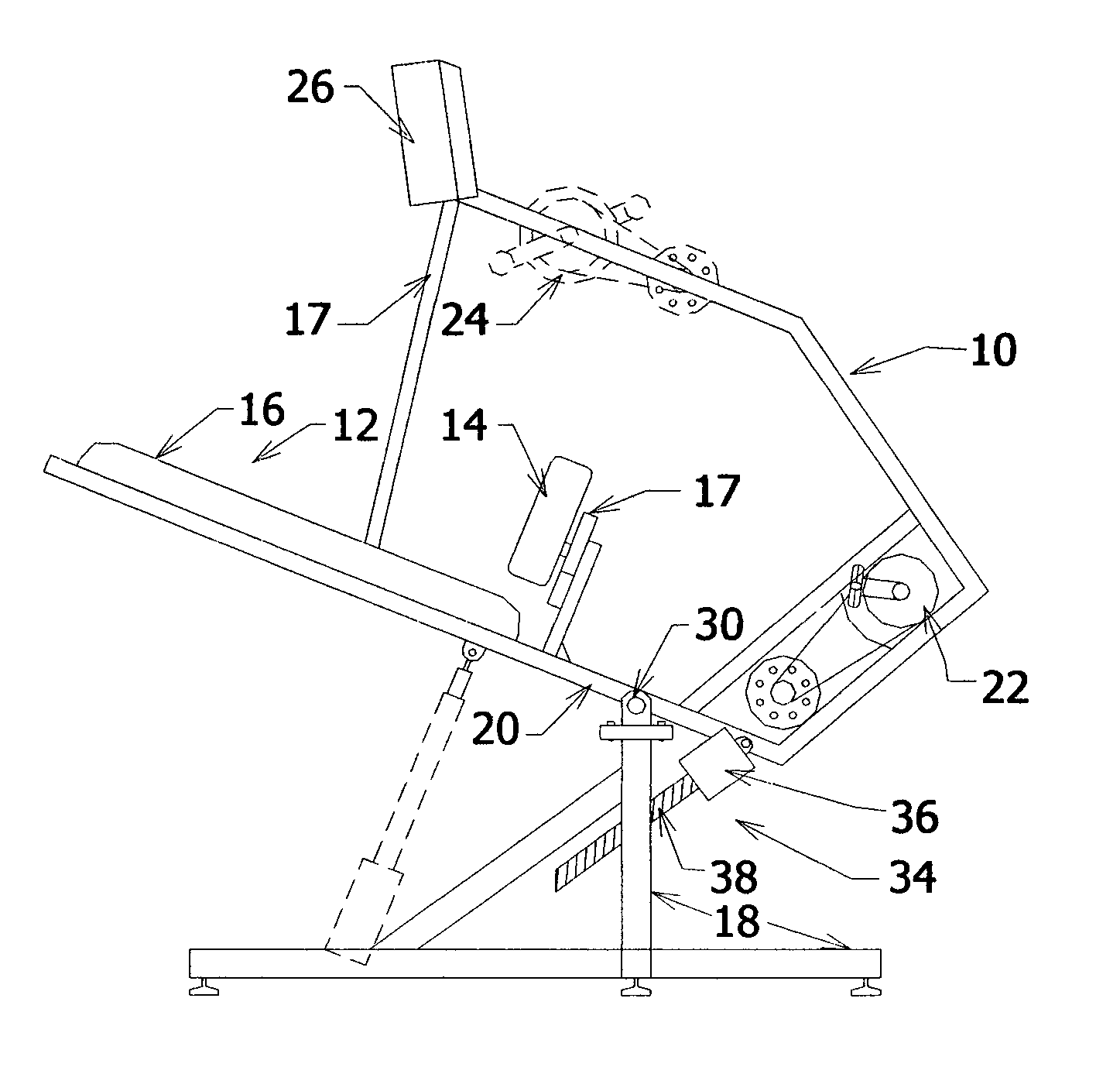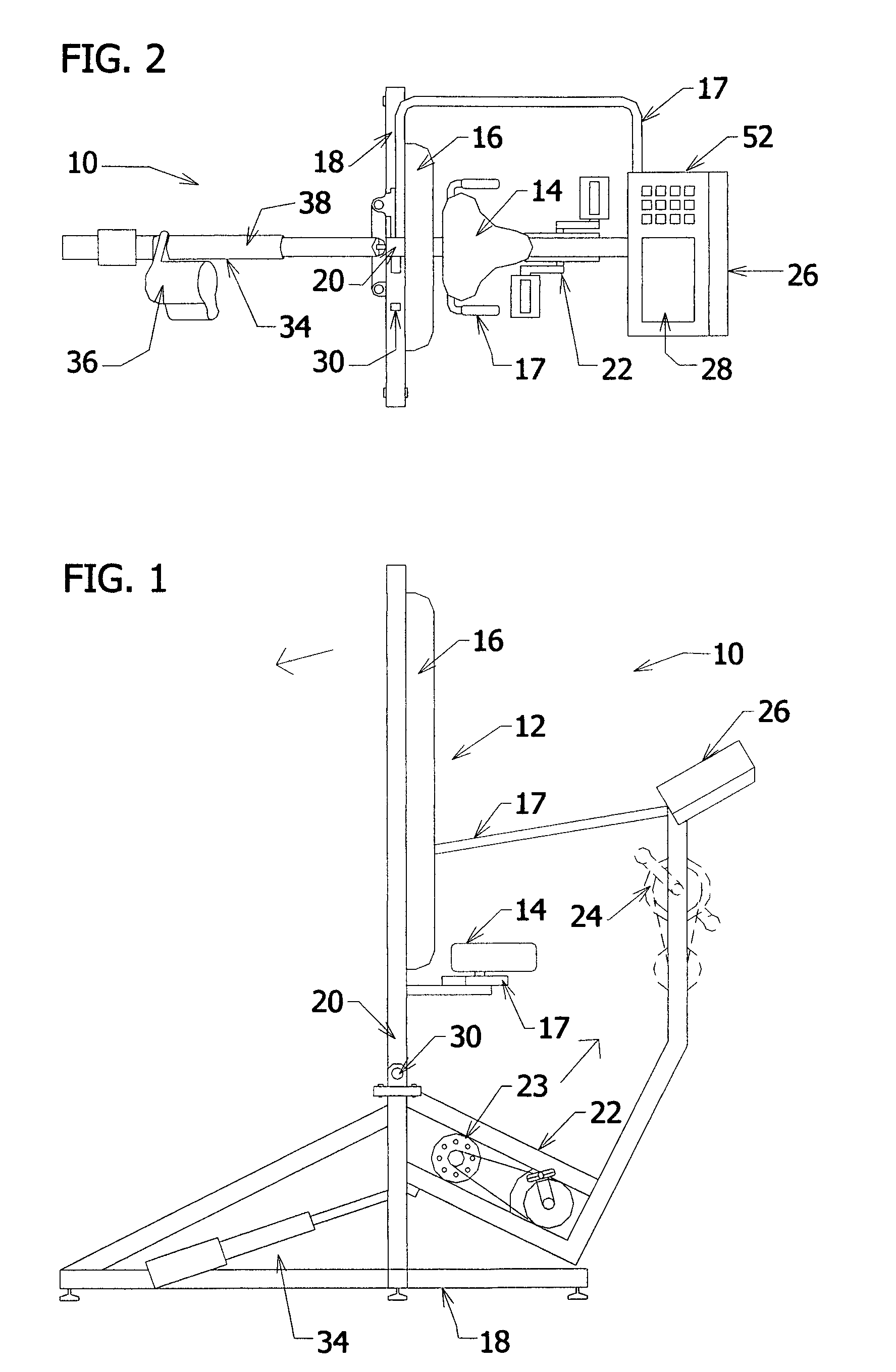[0012] In an embodiment, the present invention provides an exercise device which may include a surface for supporting a body of a user. The surface is supported above a floor by a unitary or multiple piece frame. The surface may also be mounted to the frame in such a manner so that it can change orientation relative to the floor during an exercise routine. For example, the surface may pivot forward and backward so that an
angle of inclination of the back rest and seat surface relative to the floor and to the resistance means may change between horizontal, vertical and forward beyond vertical. In anther embodiment the resistance devise may be mounted to the frame in such a manner that the orientation of the resistance devise(s) can change relative to the floor and to the back rest and seat
support surface. Also the back rest, seat surface, hand grips and the resistance means can change orientation in relation to each other and to the floor if so equipped, independently and or in any combo thereof. The surface may also pivot or rotate side to side about a
horizontal axis or rotate up to 360 degrees or more about a
vertical axis either while the surface remains horizontal or while the surface is also pivoting about a
horizontal axis. And in another embodiment the orientation of the graspable
support system may be adjusted to allow for changes in positions. Appropriate mechanical arrangements can be provided to allow the orientation change, such as worm gears, planetary gears, hydraulic actuators, etc. The orientation changing device could be manually operated or could be automatically controlled through an
electric motor,
hydraulic pump, etc. Such a unit provides physiological as well as psychological benefits.
[0013] In another embodiment, the invention provides an exercise device which is capable of being computer controlled via an integral computer, or from a separate computer via instructions received from a magnetic card, disk, direct or indirect connection to a computer via modem or similar arrangements. The computer control will provide instructions to the exercise device to control the operation of the device, such as varying the resistance provided, automatically changing the orientation of the support surface, the resistance means, if available, displaying information to the user, varying time durations for resistance levels and orientation positions, etc. to provide an infinite variety of duration, resistance and orientation combinations. Further, the computer control may
control memory devices so that the operation of the user may be recorded, either locally or at a remote site via modem, wired or
wireless transmission, as well as displaying the results of the user's actions. Various types of information relating to the use can be recorded such as date and
time of use, duration of use, functions perform, energy expended by the user,
heart rate at select intervals,
blood pressure,
respiration rates, etc. Many types of information, physiological, etc. whether recorded or not relating to the use such as energy expended by the user,
heart rate at select intervals,
blood pressure,
respiration rates, etc. can be used via the computer to control the functions of the exercise. The computer may use physiological response from the user during the workout to control the functions of the exercise devise in real time. In fact, a large number of parameters relating to the user's exercise use can be used for controlling the exercise devise and or to be recorded as the exercise is performed so that the user, a coach or trainer, or a cardiac therapist, medical personal, or others will be able, through appropriate
software and other means available, to view the entire
exercise program, or parts or summaries thereof, and compare it to other workouts or to preprogrammed workouts and calculate or re-calculate workouts based upon parameters contained in the
software for
programming future exercise workouts etc.
[0016] In an preferred embodiment the resistance devise would comprise of a generator type motor that when moved by the user produces energy,
electricity, etc. which supplies the exercise devise. Thus eliminating the need for an outside source of energy, such as an electrical outlet, etc.
[0020] For example, if the exercise device includes a bicycle pedal resistance device and or a graspable
handle resistance device, the orientation of the support surface and or the orientation of the resistance means can vary during the exercise routine to simulate an upright bike, a recumbent bike, and or a
rowing-
cycling-climbing like arm motion and or a in any varying combination thereof going uphill, level, and going downhill in conjunction with varying resistance levels at the resistance device(s). Also, by pivoting side to side and about a
vertical axis will allow the exercise device to simulate turns, both on level ground and in conjunction with simulated hills. Not only will this provide additional user interest in the use of the exercise device, Applicant believes that psychological and physiological benefits result from exercise being performed at different orientations relative to a vertical and varying degrees of hip flexion and extension, due to the varying effects of gravity and hip angularity on the exercise being performed. Interactive games or videos, displayed on the display devise and controlled thru various input devises, including buttons spaced away from the display devise, can be played which would cause changes to the duration, resistance and orientation of the support, etc. as the game or video progresses.
 Login to View More
Login to View More  Login to View More
Login to View More 


